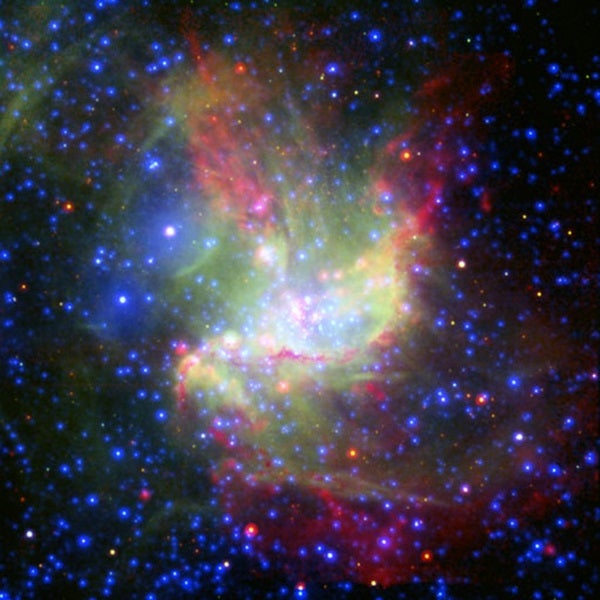Different wavelengths of light swirl together like watercolors in a new, ethereal portrait of a bright, star-forming region.
The multi-wavelength picture combines infrared, visible, and X-ray light from NASA’s Spitzer Space Telescope, the European Southern Observatory’s New Technology Telescope, and the European Space Agency’s XMM-Newton orbiting X-Ray telescope, respectively.
The colorful image offers a fresh look at the history of the star-studded region called NGC 346 and reveals new information about how stars form in the universe. NGC 346 is the brightest star-forming region in the Small Magellanic Cloud, an irregular dwarf galaxy that orbits our Milky Way galaxy, 210,000 light-years away.
“NGC 346 is an astronomical zoo,” said Dimitrios Gouliermis of the Max Planck Institute for Astronomy in Germany, lead author of a new paper describing the observations in an upcoming issue of the Astrophysical Journal. “When we combined data at various wavelengths, we were able to tease apart what’s going on in different parts of the cloud.”
Small stars are scattered throughout the NGC 346 region, while massive stars populate its center. The massive stars and most of the small stars formed at the same time out of one dense cloud, while a process called triggered star formation later created other small stars. Intense radiation from massive stars ate away at the surrounding dusty cloud, triggering gas to expand and create shock waves that compressed nearby cold dust and gas into new stars. The red-orange filaments surrounding the center of the image show where this process occurred.
But a set of even younger small stars in the region, seen as a pinkish blob at the top of the image, couldn’t be explained by this mechanism. Scientists wondered what caused this seemingly isolated group of stars to form.
By combining multi-wavelength data of NGC 346, Gouliermis says he and his team pinpointed the trigger as a very massive star that blasted apart in a supernova explosion about 50,000 years ago. According to the astronomers, this very massive star spurred the isolated young stars into existence before it died, but through a different type of triggered star formation than what occurred near the region’s center. Fierce winds from the massive star, and not radiation, pushed dust and gas together, compressing it into new stars.
The finding demonstrates that both wind- and radiation-induced triggered star formation are at play in the same cloud. According to Gouliermis, “The result shows us that star formation is a far more complicated process than we used to believe, comprising different competitive or collaborative mechanisms.”
The new image also reveals a bubble, seen as a blue halo to the left, caused by the supernova explosion that happened 50,000 years ago. Further analysis shows that this bubble is located within a large expanding gaseous shell, possibly powered by the explosion and the winds of other bright stars in its vicinity.
Infrared light (red) shows cold dust; visible light (green) denotes glowing gas; and X rays (blue) represent very warm gas. Ordinary stars appear as blue spots with white centers, while young stars enshrouded in dust appear as red spots with white centers.










